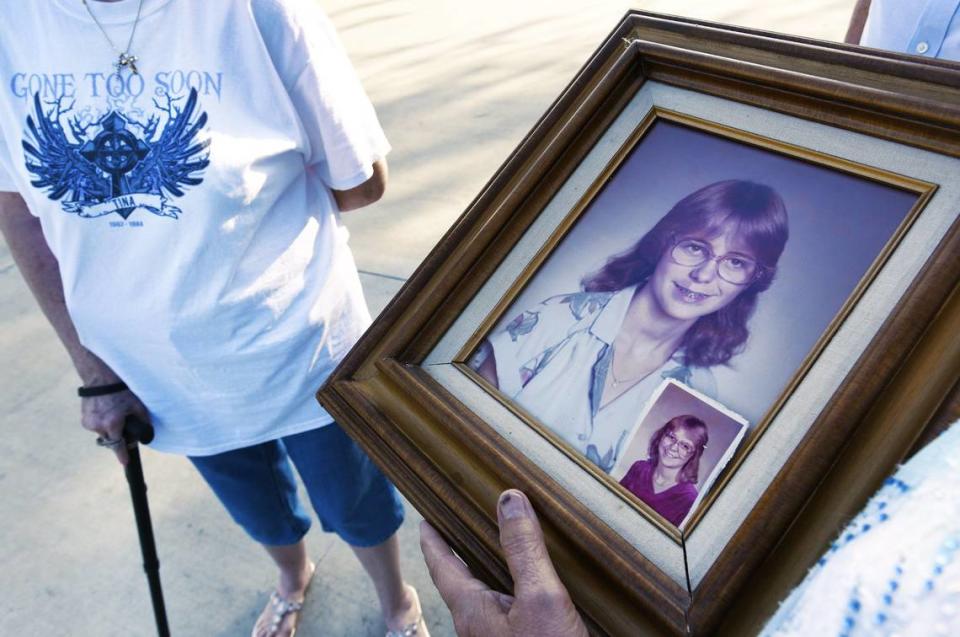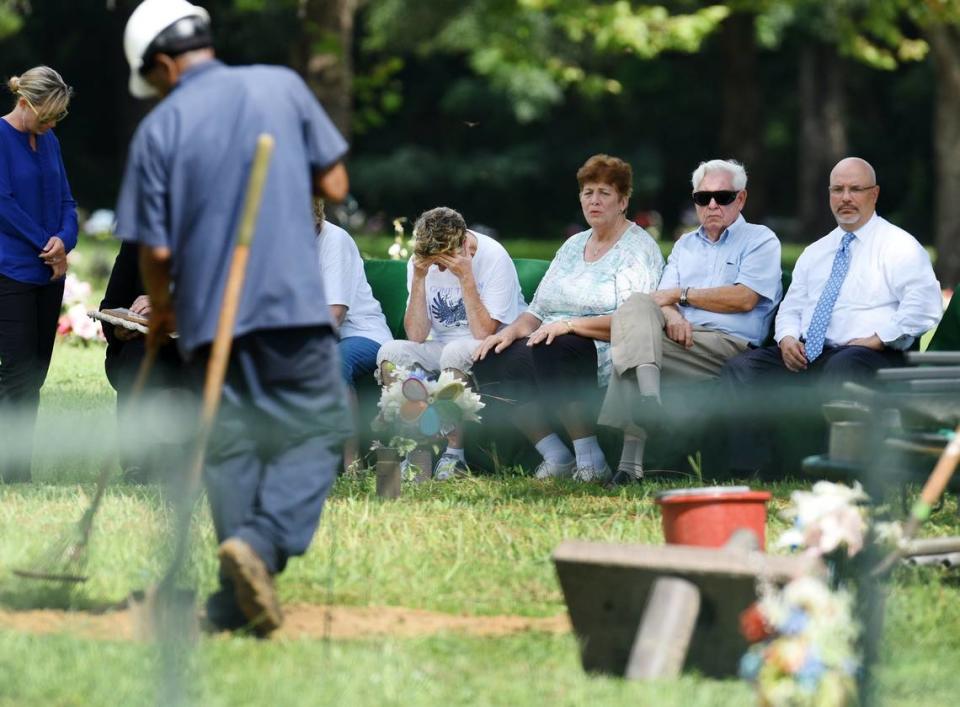Expert on 2nd Stephen Smith SC autopsy kept bones of other teen without permission, lawsuit says
A forensic anthropologist who took part in the second autopsy of Stephen Smith had the bones of a murdered Florida teenager for a decade without permission from the girl’s mother, according to a lawsuit.
Mary “Penny” Lovett Lakoskey, the teen’s mom, and her son Amos Lakoskey, filed a lawsuit in state Circuit Court in Duval County, Florida last month against Heather Walsh-Haney, an associate professor at Florida Gulf Coast University.
Walsh-Haney also has been investigated by Florida state police — but not charged — for possessing the remains of other victims without authorization.
Earlier this month, Walsh-Haney observed the second autopsy of Smith, whose body was found on a rural road in Hampton County, SC, in 2015. His death was initially ruled a hit-and-run, but the South Carolina Law Enforcement Division earlier this month said Smith was murdered.
Walsh-Haney was part of a new team assembled by the lawyers for Smith’s mother, Sandy, to conduct the second autopsy.
Smith’s death received renewed interest after disgraced lawyer Alex Murdaugh was convicted in March of murdering his wife and son. SLED previously announced it was reopening its investigation into Smith’s death because of information, so far undisclosed, that investigators uncovered during the Murdaugh investigation.
No known evidence has linked the Murdaughs to Smith’s death.
The second autopsy team — called the “dream team” by the lawyers — was led by Dr. Dan Schultz, president and chief pathologist for a private company in Tampa called Final Diagnosis. Also on the team was Dr. D’Michelle DuPre, a retired forensic pathologist in Columbia who was the medical examiner in Miami and also a professor.
Walsh-Haney responded in an email to The State that she is limited in what she can say about the lawsuit since it is pending. She wrote generally about the role of a forensic anthropologist and the fact that it is the medical examiner who makes the decisions about remains and communication with families.
Eric Bland, an attorney for Sandy Smith, said he was unaware of the pending lawsuit.
“Dr. Haney came highly recommended. There are not many in her field of expertise that are pathology anthropologists who do autopsies. I did not know of her name or reputation prior to the Stephen Smith matter.”

A career in forensic anthropology
Walsh-Haney is known for “experiential learning” — going into the field to conduct investigations and exposing students to the same.
“Being directly involved in casework helps students understand the many roles individual analysts play as part of a forensic investigation. For example, I’m focused on skeletal remains, but how do I collect evidence without impacting other aspects of the investigation?” she wrote on her profile on the Florida Gulf Coast University website.
She has identified bodies long unknown and worked on cold cases. She and two graduate students worked at the Tulsa, Oklahoma, site, where human remains were unearthed from a 1921 race massacre.
Walsh-Haney was a graduate student at the University of Florida when she worked for three weeks at Ground Zero after the Sept. 11, 2001 attack on the World Trade Center. She was asked to study what was believed to be a crime scene off the Gulf coast of Sarasota, but she instead discovered a 7,000-year-old Native American ancestral burial site.
She lectures widely, has appeared on national news shows and works with eight Florida medical examiners, having handled more than 500 forensic anthropology cases in her career.
She said she owes a lot to her mentor in college, Dr. William Maples and the lessons he taught students.
“Chief among those lessons is the position of trust and responsibility that we must accept when we engage in forensic endeavors — whether in support of law enforcement activities, human rights work, or academic research and study,” she wrote in an email to The State.
But her work has not been without criticism. The Florida Times-Union reported in 2019 her services were not being used by the medical examiner in Lee, Hendry and Glades counties because of mistrust issues.
When asked about these issues by The State, Walsh-Haney responded, “The issue of trust had been raised during investigative interviews. The report (by Florida Department of Law Enforcement) did not state that the basis for the mistrust was founded in anything that I did wrong and, in fact, I maintain without equivocation that I did not do anything improper or unethical in the performance of my work. Otherwise, I decline to engage in further discussions regarding misguided and misleading allegations from more than 15 years ago.”
Previous lawsuit in federal court
Lakoskey first filed a lawsuit in federal court against Walsh-Haney and three medical examiners in 2019. A panel of judges ruled that the group had immunity because of their official positions and dismissed the case. Lakoskey then elected to pursue a lawsuit in state court last month for emotional pain she endured.
Lakoskey’s daughter, Tina Lovett, 17, went missing from their Jacksonville, Florida, home in April 1984. Her body was found May 8, 1984, naked, face down in an area where people dumped broken appliances and dead animals. The body was so badly decomposed, the medical examiner at the time, Bonafacio Floro, could not tell precisely the nature of her wounds but ruled the death a homicide.
The body was sent from the Medical Examiner’s Office in Jacksonville to the Alternate Internment Funeral Home in Jacksonville and buried at Riverside Memorial Park.
What Lakosky didn’t know was that Floro sent only the bones from her daughter’s legs and feet and kept her rib cage, femur and skull, the lawsuit says.
It does not say why. Floro kept the remains until 1992, when they were sent to C.A. Pound Laboratory at the University of Florida for analysis. In 2000, Walsh-Haney, then employed at the University of Florida, sent the remains back to the original medical examiner’s office. In 2005, the remains were sent to Walsh-Haney, then employed at Florida Gulf Coast University.
Lavoskey did not learn until 2017, when the new Jacksonville medical examiner contacted her, that she did not have all that remained of her daughter and that those remains had spent 33 years being shuffled between the two Florida universities and the medical examiner’s office.
Lavoskey had her daughter exhumed in 2017 and confirmed only her daughter’s leg and feet bones were inside the casket, and then reburied all of her remains.
“These were outrageous, extreme and went beyond all bounds of decency and would be regarded as shocking, atrocious, odious and utterly intolerable in a civilized society,” the lawsuit says.

When the Florida Times Union asked in 2017 why the medical examiner’s office had possession of the bones for years, Medical Examiner Valerie Rao said Lovett’s case was still open. She also said her office did not have the space to keep so many remains.
But the lawsuit says the Lovett case had been closed for decades. One man arrested was released for insufficient evidence and died not long after.
In addition to Walsh-Haney and Floro, the lawsuit names Medical Examiners Margarita Arruza and Rao.
In 2017, Walsh-Haney sent the Times-Union a one-page statement.
She said she was asked as an anthropology consultant to take possession of Lovett’s bones on behalf of the medical examiner’s office. It was part of a larger effort to inventory skeletal remains.
“They were stored at the Medical Examiner’s Office in Naples,” Walsh-Haney said.
Other cases
Walsh-Haney was also investigated by the Florida Department of Law Enforcement in 2008 after two graduate students volunteering in her program found the remains of two men who had been murdered six years before — Frankie De’Angelo Dennard and Jeffrey Ivan Gwyn Jr.
The students were preparing unidentified remains to be shipped to another lab so they could be identified using DNA analysis, but were puzzled when they realized the two men had already been identified. The students questioned why the remains had not already been returned to their families and sought answers from Florida Gulf Coast University officials before going to law enforcement.
The students told investigators they asked Walsh-Haney why she had the bones and were told they had been donated, according to a report by the Florida Department of Law Enforcement.
The District 4 Medical Examiner’s Office confirmed to investigators Walsh-Haney had remains from 30 to 40 of its cases in her possession at the Naples Medical Examiner’s Office and that she had a right to possess the remains of Dennard and Gwyn, according to the report.
But the Gwyn family in Atlanta said they did not give permission for anyone to have the bones. The Dennard family said they did not want his bones returned, investigators found.
While Walsh-Haney reported that remains from other cases had been donated to her by the Lee County Sheriff’s Office, detectives there said that they did not give their permission and did not have the authority to do so, investigators found.
Ultimately, an assistant state attorney said he did not see any criminal intent and no charges were brought against Walsh-Haney.
Walsh-Haney told The State she accepts human remains for forensic analysis at the request of various medical examiners and, sometimes, law enforcement agencies. She said she allows highly qualified students to work with the remains under her supervision.
“This is what I refer to as ‘casework’ and students who have had criminal history checks and performed well academically have the opportunity to accompany me while I do this work.”
She said that is similar to what medical students experience in teaching hospitals.
“Remains from forensic cases are never used as exemplars or the like for general coursework, study, or research,” she said.
Instead, donated human skeletal remains, nonhuman specimens, and skeletal casts are used.
“One of the principle errors made by those who are not familiar with the type of work I do is to assume that the former (forensic cases) are used for academic purposes in the same manner as the latter (donated collections),” she said.

 Yahoo Finance
Yahoo Finance 